Baker R.C. Flow Measurement Handbook: Industrial Designs, Operating Principles, Performance, and Applications
Подождите немного. Документ загружается.

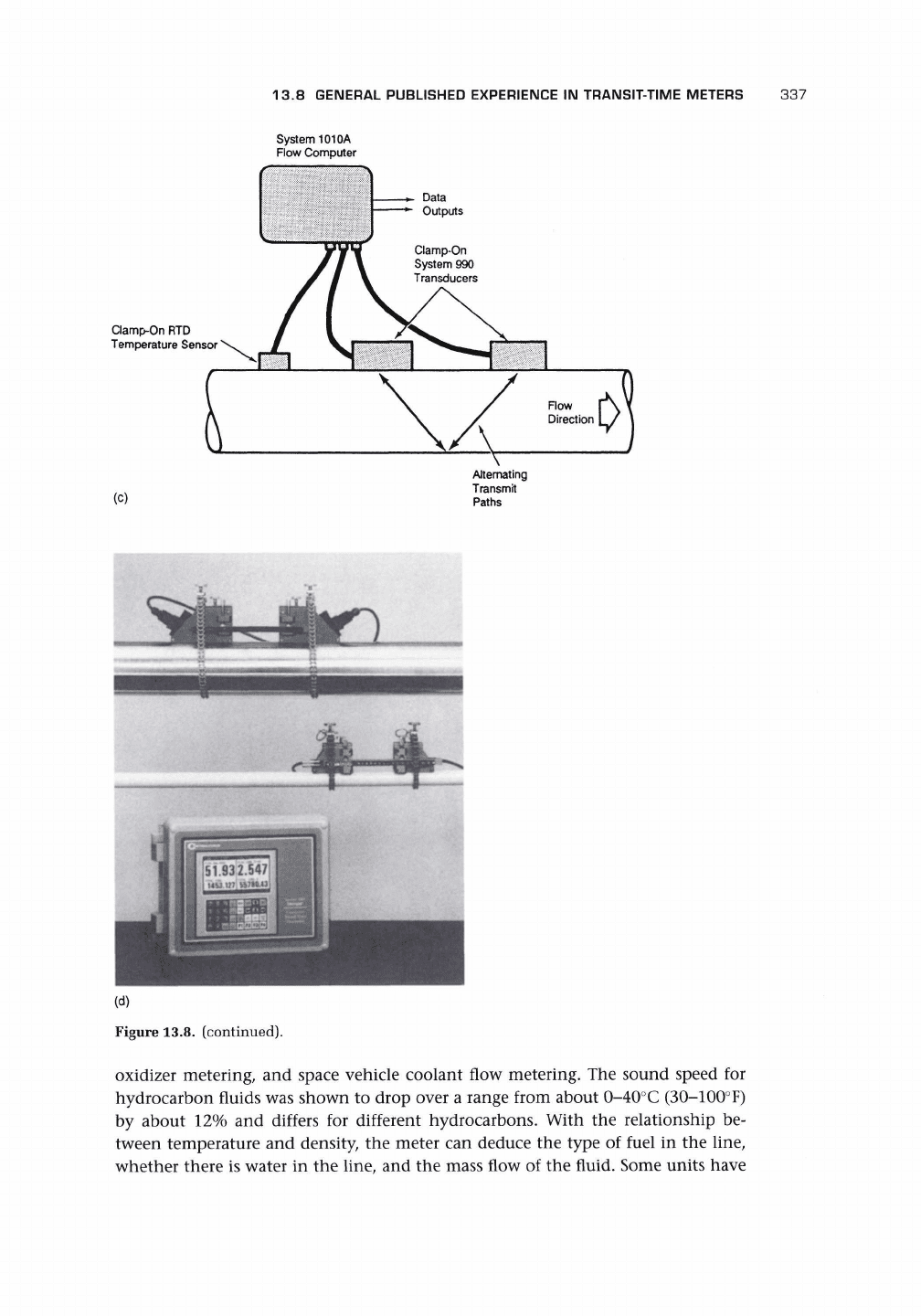
13.8 GENERAL PUBLISHED EXPERIENCE IN TRANSIT-TIME METERS
337
System 1010A
Flow Computer
Data
Outputs
Clamp-On RTD
Temperature Sensor
Clamp-On
System 990
Transducers
Flow
Direction
(c)
7
Alternating
Transmit
Paths
Figure 13.8. (continued).
oxidizer metering, and space vehicle coolant flow metering. The sound speed for
hydrocarbon fluids was shown to drop over a range from about 0-40°C (30-100°F)
by about 12% and differs for different hydrocarbons. With the relationship be-
tween temperature and density, the meter can deduce the type of fuel in the line,
whether there is water in the line, and the mass flow of the fluid. Some units have
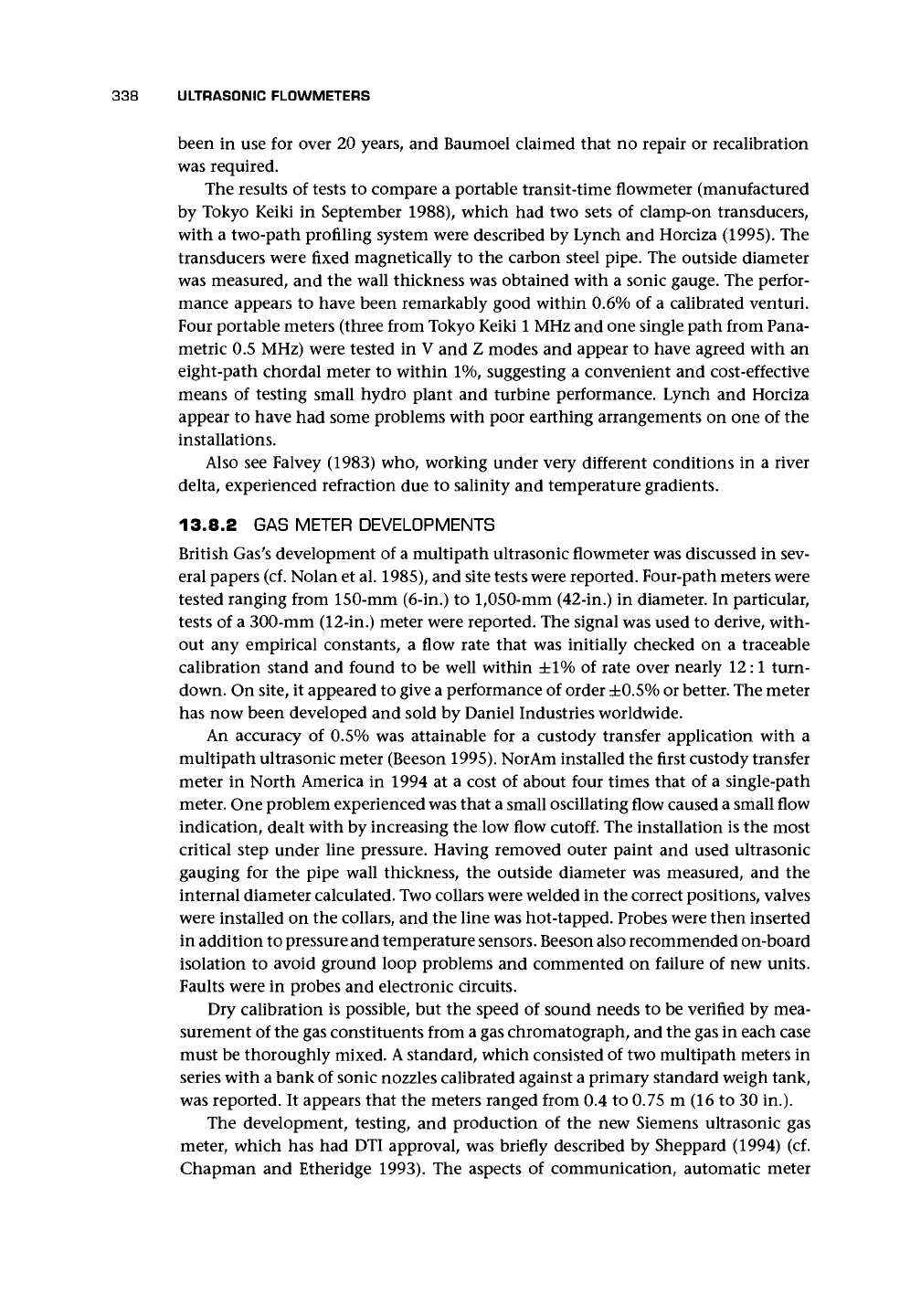
338 ULTRASONIC FLOWMETERS
been in use for over 20 years, and Baumoel claimed that no repair or recalibration
was required.
The results of tests to compare a portable transit-time flowmeter (manufactured
by Tokyo Keiki in September 1988), which had two sets of clamp-on transducers,
with a two-path profiling system were described by Lynch and Horciza (1995). The
transducers were fixed magnetically to the carbon steel pipe. The outside diameter
was measured, and the wall thickness was obtained with a sonic gauge. The perfor-
mance appears to have been remarkably good within 0.6% of a calibrated venturi.
Four portable meters (three from Tokyo Keiki
1
MHz and one single path from Pana-
metric 0.5 MHz) were tested in V and Z modes and appear to have agreed with an
eight-path chordal meter to within 1%, suggesting a convenient and cost-effective
means of testing small hydro plant and turbine performance. Lynch and Horciza
appear to have had some problems with poor earthing arrangements on one of the
installations.
Also see Falvey (1983) who, working under very different conditions in a river
delta, experienced refraction due to salinity and temperature gradients.
13.8.2 GAS METER DEVELOPMENTS
British Gas's development of a multipath ultrasonic flowmeter was discussed in sev-
eral papers (cf. Nolan et al. 1985), and site tests were reported. Four-path meters were
tested ranging from 150-mm (6-in.) to
1,050-mm
(42-in.) in diameter. In particular,
tests of a 300-mm (12-in.) meter were reported. The signal was used to derive, with-
out any empirical constants, a flow rate that was initially checked on a traceable
calibration stand and found to be well within ±1% of rate over nearly 12:1 turn-
down. On site, it appeared to give a performance of order ±0.5% or better. The meter
has now been developed and sold by Daniel Industries worldwide.
An accuracy of 0.5% was attainable for a custody transfer application with a
multipath ultrasonic meter (Beeson 1995). NorAm installed the first custody transfer
meter in North America in 1994 at a cost of about four times that of a single-path
meter. One problem experienced was that a small oscillating flow caused a small flow
indication, dealt with by increasing the low flow
cutoff.
The installation is the most
critical step under line pressure. Having removed outer paint and used ultrasonic
gauging for the pipe wall thickness, the outside diameter was measured, and the
internal diameter calculated. Two collars were welded in the correct positions, valves
were installed on the collars, and the line was hot-tapped. Probes were then inserted
in addition to pressure and temperature sensors. Beeson also recommended on-board
isolation to avoid ground loop problems and commented on failure of new units.
Faults were in probes and electronic circuits.
Dry calibration is possible, but the speed of sound needs to be verified by mea-
surement of the gas constituents from a gas chromatograph, and the gas in each case
must be thoroughly mixed.
A
standard, which consisted of two multipath meters in
series with a bank of sonic nozzles calibrated against a primary standard weigh tank,
was reported. It appears that the meters ranged from 0.4 to 0.75 m (16 to 30 in.).
The development, testing, and production of the new Siemens ultrasonic gas
meter, which has had DTI approval, was briefly described by Sheppard (1994) (cf.
Chapman and Etheridge 1993). The aspects of communication, automatic meter
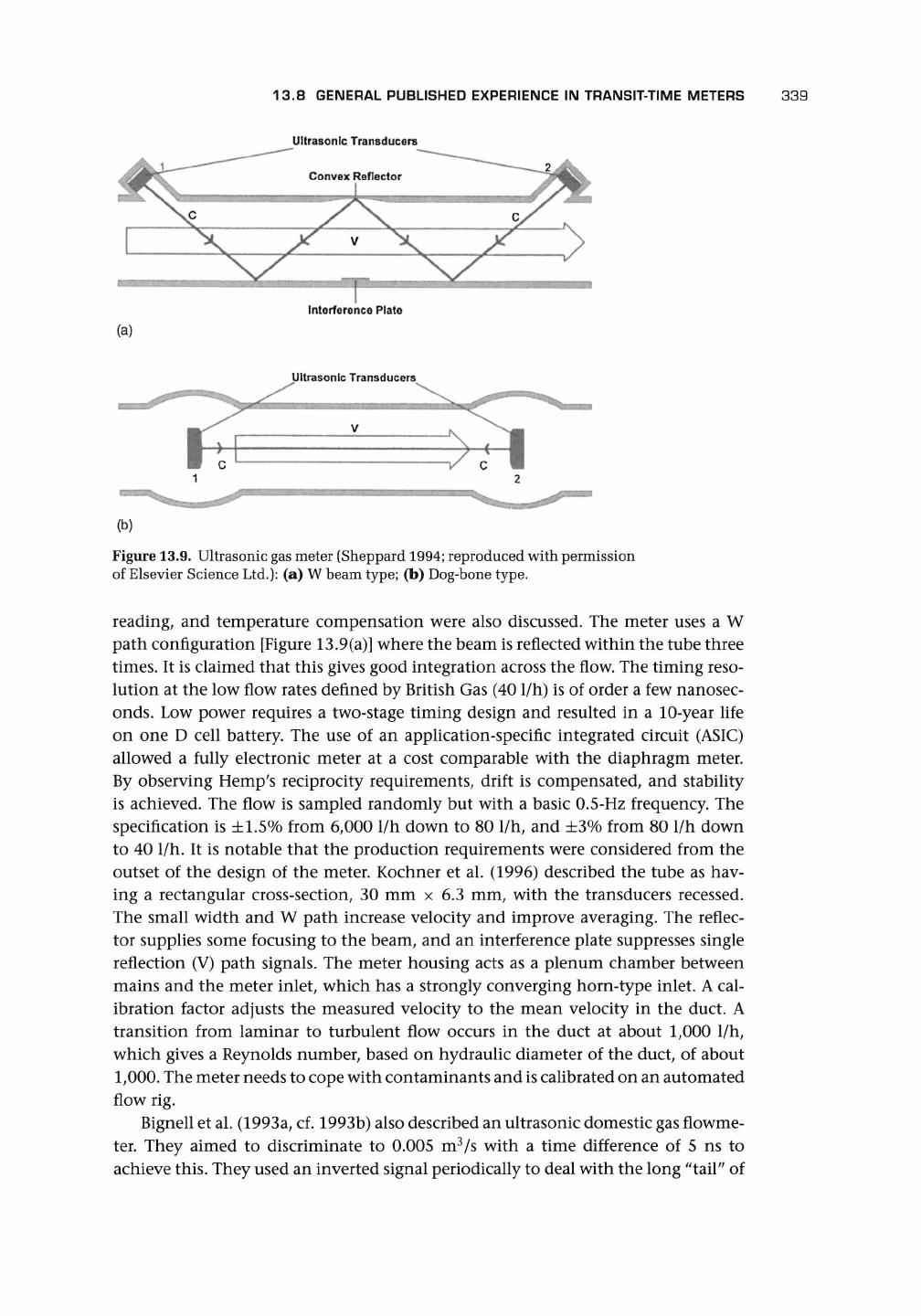
13.8 GENERAL PUBLISHED EXPERIENCE IN TRANSIT-TIME METERS
339
Ultrasonic Transducers
(a)
I
Interference Plate
iftrasonfc Transducers
Figure 13.9. Ultrasonic gas meter (Sheppard
1994;
reproduced with permission
of Elsevier Science Ltd.): (a) W beam type; (b) Dog-bone type.
reading, and temperature compensation were also discussed. The meter uses a W
path configuration [Figure 13.9(a)] where the beam is reflected within the tube three
times.
It is claimed that this gives good integration across the flow. The timing reso-
lution at the low flow rates defined by British Gas (40 1/h) is of order a few nanosec-
onds.
Low power requires a two-stage timing design and resulted in a 10-year life
on one D cell battery. The use of an application-specific integrated circuit (ASIC)
allowed a fully electronic meter at a cost comparable with the diaphragm meter.
By observing Hemp's reciprocity requirements, drift is compensated, and stability
is achieved. The flow is sampled randomly but with a basic 0.5-Hz frequency. The
specification is ±1.5% from 6,000 1/h down to 80 1/h, and ±3% from 80 1/h down
to 40 1/h. It is notable that the production requirements were considered from the
outset of the design of the meter. Kochner et al. (1996) described the tube as hav-
ing a rectangular cross-section, 30 mm x 6.3 mm, with the transducers recessed.
The small width and W path increase velocity and improve averaging. The reflec-
tor supplies some focusing to the beam, and an interference plate suppresses single
reflection (V) path signals. The meter housing acts as a plenum chamber between
mains and the meter inlet, which has a strongly converging horn-type inlet. A cal-
ibration factor adjusts the measured velocity to the mean velocity in the duct. A
transition from laminar to turbulent flow occurs in the duct at about 1,000 1/h,
which gives a Reynolds number, based on hydraulic diameter of the duct, of about
1,000.
The meter needs to cope with contaminants and
is
calibrated on an automated
flow rig.
Bignell et
al.
(1993a, cf. 1993b) also described an ultrasonic domestic gas flowme-
ter. They aimed to discriminate to 0.005 m
3
/s with a time difference of 5 ns to
achieve this. They used an inverted signal periodically to deal with the long "tail" of
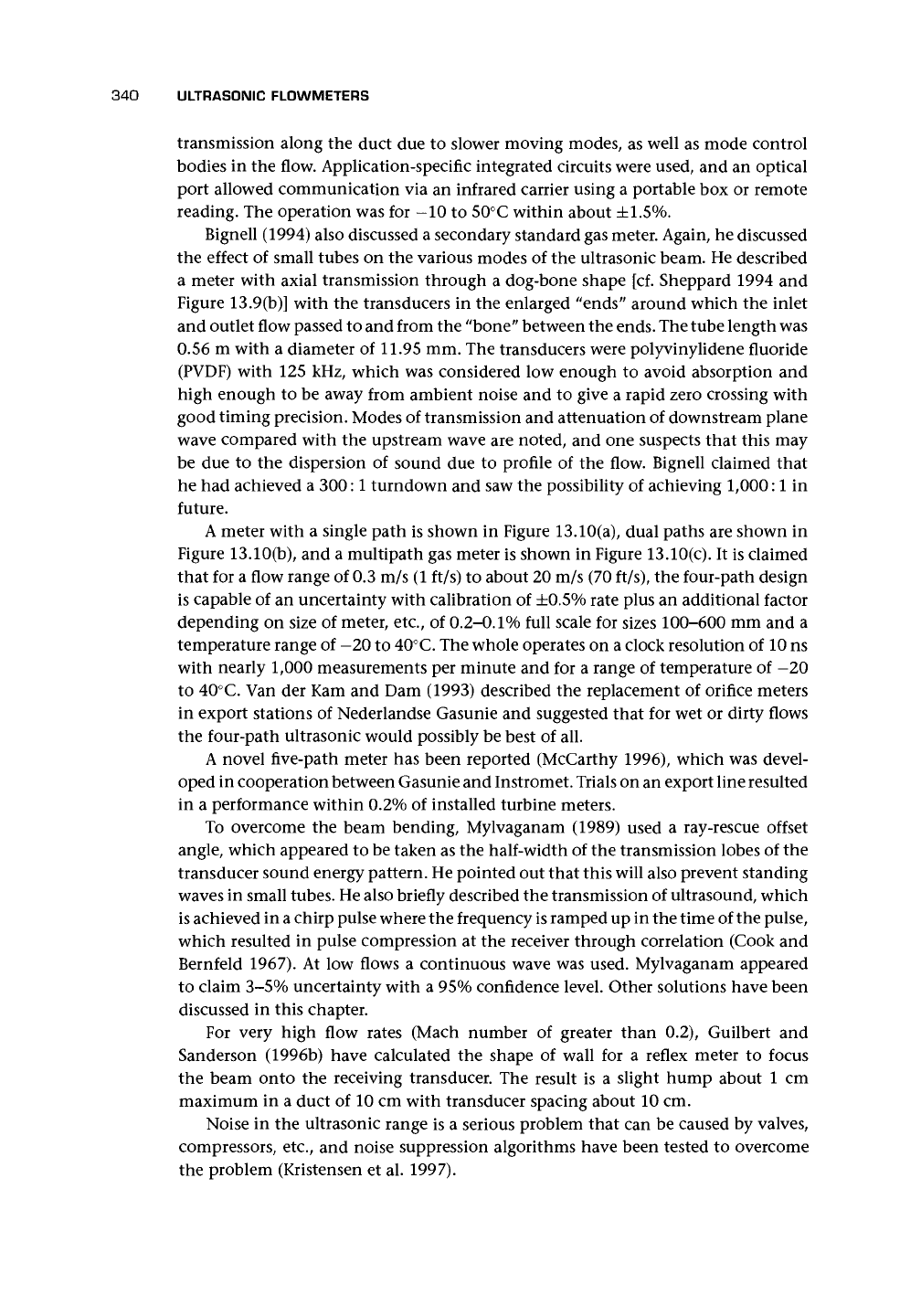
340 ULTRASONIC FLOWMETERS
transmission along the duct due to slower moving modes, as well as mode control
bodies in the flow. Application-specific integrated circuits were used, and an optical
port allowed communication via an infrared carrier using a portable box or remote
reading. The operation was for -10 to 50°C within about
±1.5%.
Bignell (1994) also discussed a secondary standard gas meter. Again, he discussed
the effect of small tubes on the various modes of the ultrasonic beam. He described
a meter with axial transmission through a dog-bone shape [cf. Sheppard 1994 and
Figure 13.9(b)] with the transducers in the enlarged "ends" around which the inlet
and outlet flow passed to and from the "bone" between the ends. The tube length was
0.56 m with a diameter of 11.95 mm. The transducers were polyvinylidene fluoride
(PVDF) with 125 kHz, which was considered low enough to avoid absorption and
high enough to be away from ambient noise and to give a rapid zero crossing with
good timing precision. Modes of transmission and attenuation of downstream plane
wave compared with the upstream wave are noted, and one suspects that this may
be due to the dispersion of sound due to profile of the flow. Bignell claimed that
he had achieved a 300:1 turndown and saw the possibility of achieving
1,000:1
in
future.
A meter with a single path is shown in Figure 13.10(a), dual paths are shown in
Figure 13.10(b), and a multipath gas meter is shown in Figure 13.10(c). It is claimed
that for a flow range of 0.3 m/s (1 ft/s) to about 20 m/s (70 ft/s), the four-path design
is capable of an uncertainty with calibration of ±0.5% rate plus an additional factor
depending on size of meter, etc., of
0.2-0.1%
full scale for sizes 100-600 mm and a
temperature range of -20 to 40°C. The whole operates on a clock resolution of 10 ns
with nearly 1,000 measurements per minute and for a range of temperature of -20
to 40°C. Van der Kam and Dam (1993) described the replacement of orifice meters
in export stations of Nederlandse Gasunie and suggested that for wet or dirty flows
the four-path ultrasonic would possibly be best of all.
A novel five-path meter has been reported (McCarthy 1996), which was devel-
oped in cooperation between Gasunie and Instromet. Trials on an export line resulted
in a performance within 0.2% of installed turbine meters.
To overcome the beam bending, Mylvaganam (1989) used a ray-rescue offset
angle, which appeared to be taken as the half-width of the transmission lobes of the
transducer sound energy pattern. He pointed out that this will also prevent standing
waves in small tubes. He also briefly described the transmission of ultrasound, which
is achieved in a chirp pulse where the frequency
is
ramped up in the time of the pulse,
which resulted in pulse compression at the receiver through correlation (Cook and
Bernfeld 1967). At low flows a continuous wave was used. Mylvaganam appeared
to claim 3-5% uncertainty with a 95% confidence level. Other solutions have been
discussed in this chapter.
For very high flow rates (Mach number of greater than 0.2), Guilbert and
Sanderson (1996b) have calculated the shape of wall for a reflex meter to focus
the beam onto the receiving transducer. The result is a slight hump about 1 cm
maximum in a duct of 10 cm with transducer spacing about 10 cm.
Noise in the ultrasonic range is a serious problem that can be caused by valves,
compressors, etc., and noise suppression algorithms have been tested to overcome
the problem (Kristensen et al. 1997).

13.8 GENERAL PUBLISHED EXPERIENCE IN TRANSIT-TIME METERS
341
ELECTRONICS HOUSING REMOVED
FOR CLARITY
r
a
f
c
ENCLOSURE SHOWN ROTATED 9CT
(a)
SECTION
"A-A"
ROTATED
90*
Figure 13.10. Ultrasonic gas meters (reproduced with permission from Daniel
Industries,
Inc.):
(a) Drawing of single path; (b) Drawing of dual path; (c) Draw-
ing of multipath.

342 ULTRASONIC FLOWMETERS
HOUSING REMOVED
TRANSDUCER
LOCATION
.
B1
A
ENCLOSURE SHOWN ROTATED 97
(b)
SECTION "A-A"
ROTATED 90*
Figure 13.10. (continued).
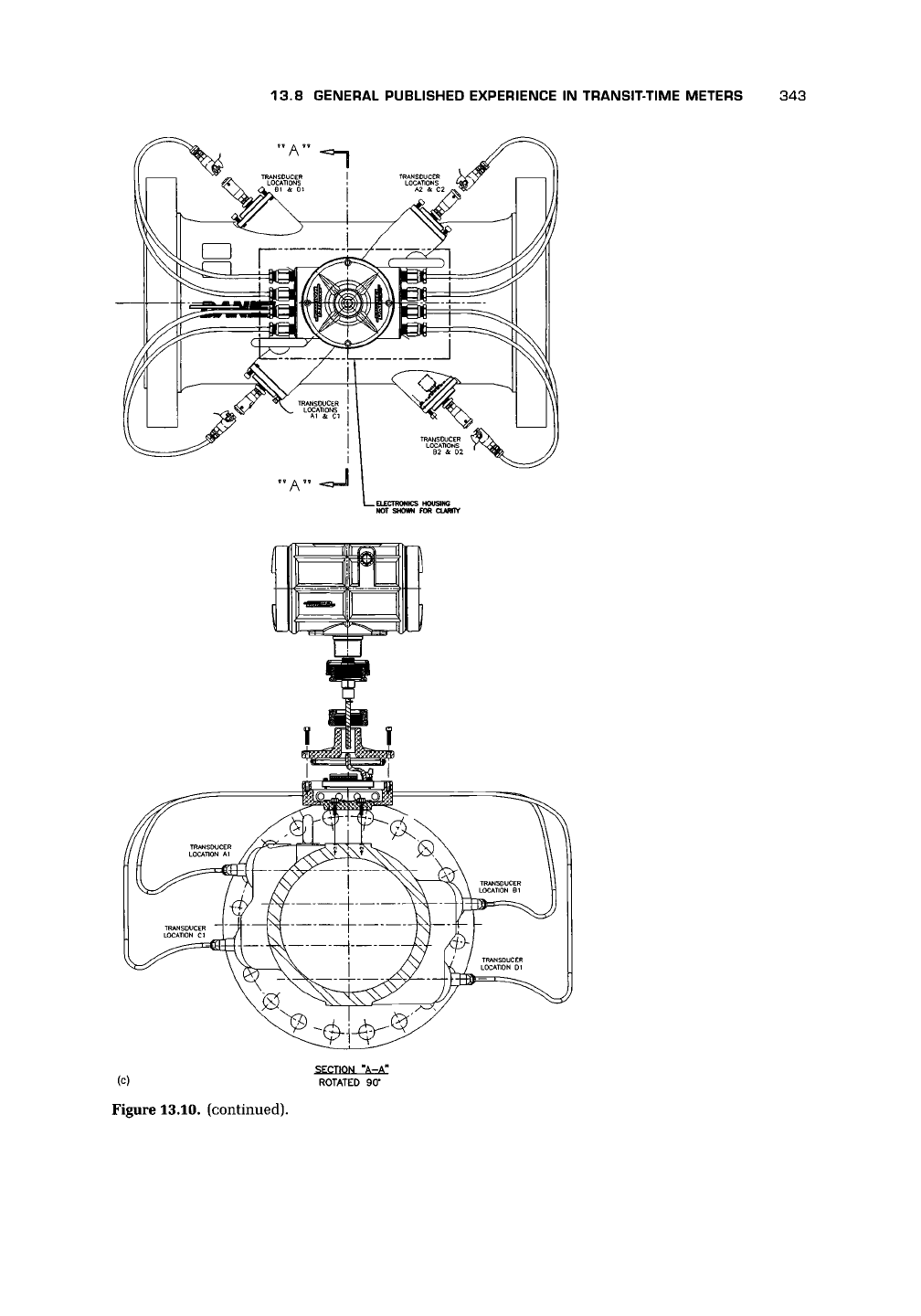
13.8 GENERAL PUBLISHED EXPERIENCE
IN
TRANSIT-TIME METERS
343
(c)
Figure
13.10. (continued).
SECTION
"A-A"
ROTATED
90'
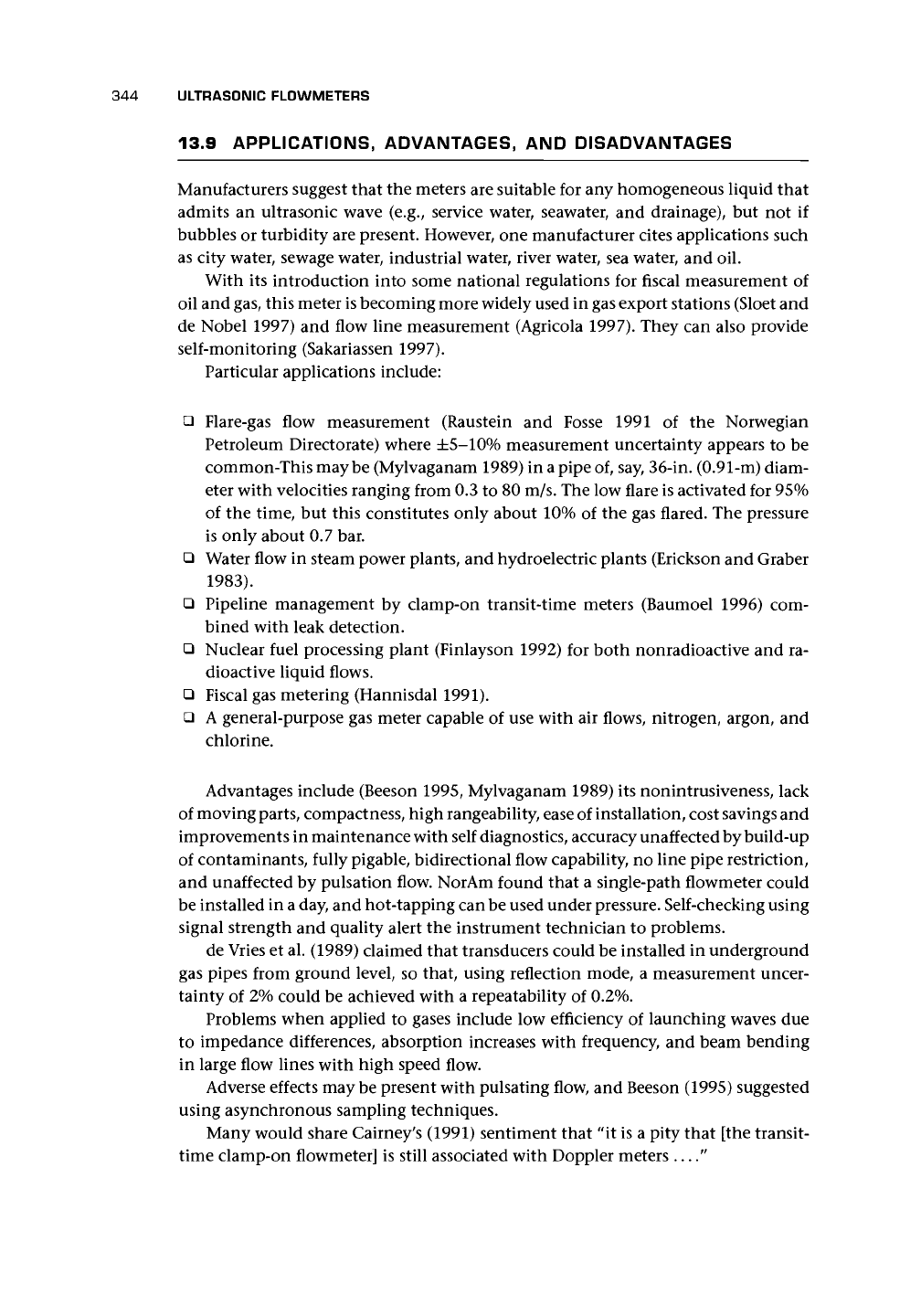
344 ULTRASONIC FLOWMETERS
13.9 APPLICATIONS, ADVANTAGES, AND DISADVANTAGES
Manufacturers suggest that the meters are suitable for any homogeneous liquid that
admits an ultrasonic wave (e.g., service water, seawater, and drainage), but not if
bubbles or turbidity are present. However, one manufacturer cites applications such
as city water, sewage water, industrial water, river water, sea water, and oil.
With its introduction into some national regulations for fiscal measurement of
oil and
gas,
this meter is becoming more widely used in gas export stations (Sloet and
de Nobel 1997) and flow line measurement (Agricola 1997). They can also provide
self-monitoring (Sakariassen 1997).
Particular applications include:
• Flare-gas flow measurement (Raustein and Fosse 1991 of the Norwegian
Petroleum Directorate) where ±5-10% measurement uncertainty appears to be
common-This maybe (Mylvaganam 1989) in a pipe of, say, 36-in. (0.91-m) diam-
eter with velocities ranging from 0.3 to 80 m/s. The low flare is activated for 95%
of the time, but this constitutes only about 10% of the gas flared. The pressure
is only about 0.7 bar.
• Water flow in steam power plants, and hydroelectric plants (Erickson and Graber
1983).
• Pipeline management by clamp-on transit-time meters (Baumoel 1996) com-
bined with leak detection.
• Nuclear fuel processing plant (Finlayson 1992) for both nonradioactive and ra-
dioactive liquid flows.
• Fiscal gas metering (Hannisdal 1991).
• A general-purpose gas meter capable of use with air flows, nitrogen, argon, and
chlorine.
Advantages include (Beeson 1995, Mylvaganam 1989) its nonintrusiveness, lack
of moving
parts,
compactness, high rangeability, ease of installation, cost savings and
improvements in maintenance with self diagnostics, accuracy unaffected by build-up
of contaminants, fully pigable, bidirectional flow capability, no line pipe restriction,
and unaffected by pulsation flow. NorAm found that a single-path flowmeter could
be installed in a day, and hot-tapping can be used under pressure. Self-checking using
signal strength and quality alert the instrument technician to problems.
de Vries et al. (1989) claimed that transducers could be installed in underground
gas pipes from ground level, so that, using reflection mode, a measurement uncer-
tainty of 2% could be achieved with a repeatability of 0.2%.
Problems when applied to gases include low efficiency of launching waves due
to impedance differences, absorption increases with frequency, and beam bending
in large flow lines with high speed flow.
Adverse effects may be present with pulsating flow, and Beeson (1995) suggested
using asynchronous sampling techniques.
Many would share Cairney's (1991) sentiment that "it is a pity that [the transit-
time clamp-on flowmeter] is still associated with Doppler meters "
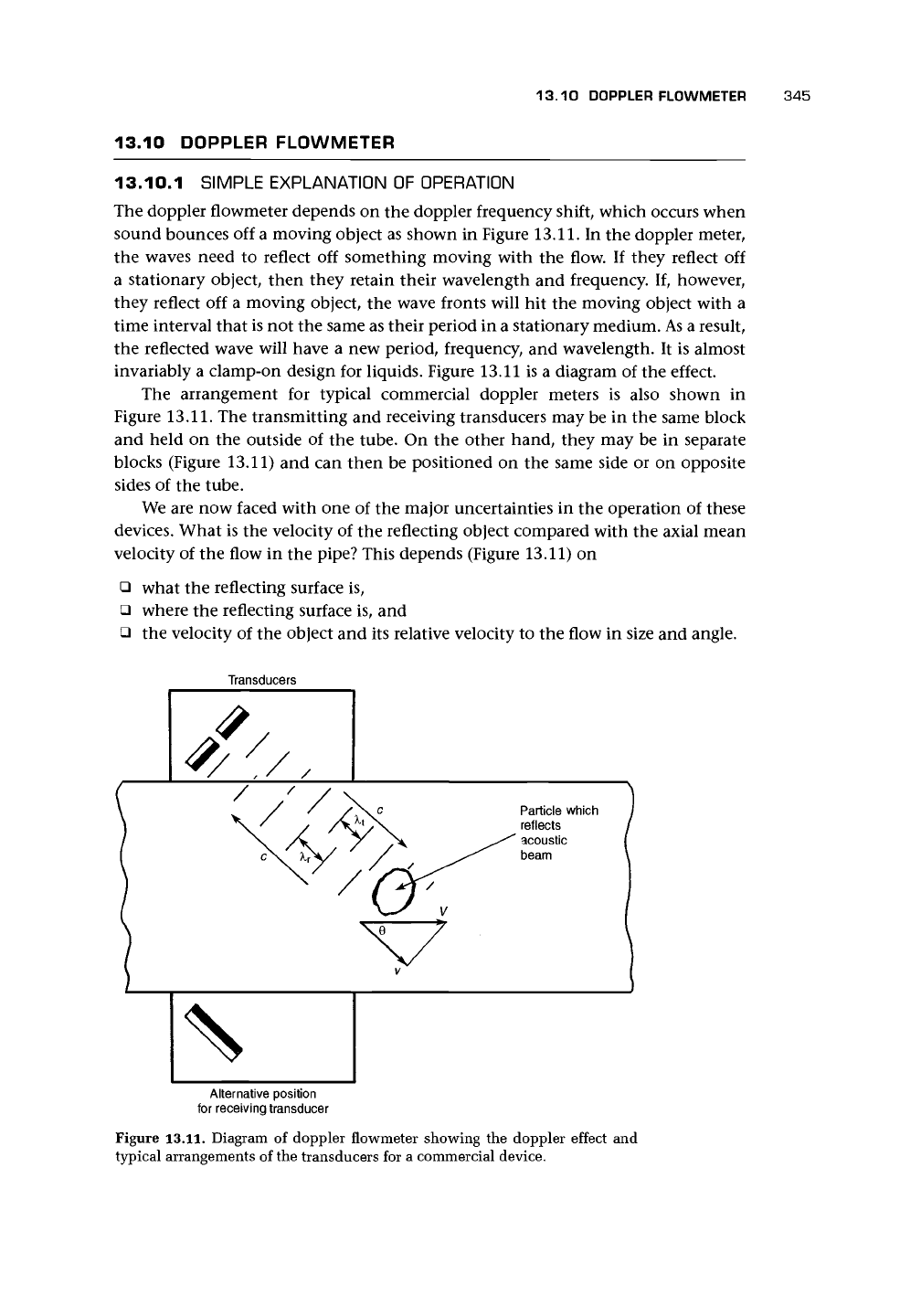
13.10 DOPPLER FLOWMETER 345
13.10 DOPPLER FLOWMETER
13.10.1 SIMPLE EXPLANATION OF OPERATION
The doppler flowmeter depends on the doppler frequency shift, which occurs when
sound bounces off a moving object as shown in Figure
13.11.
In the doppler meter,
the waves need to reflect off something moving with the flow. If they reflect off
a stationary object, then they retain their wavelength and frequency. If, however,
they reflect off a moving object, the wave fronts will hit the moving object with a
time interval that is not the same as their period in a stationary medium. As a result,
the reflected wave will have a new period, frequency, and wavelength. It is almost
invariably a clamp-on design for liquids. Figure 13.11 is a diagram of the effect.
The arrangement for typical commercial doppler meters is also shown in
Figure
13.11.
The transmitting and receiving transducers may be in the same block
and held on the outside of the tube. On the other hand, they may be in separate
blocks (Figure 13.11) and can then be positioned on the same side or on opposite
sides of the tube.
We are now faced with one of the major uncertainties in the operation of these
devices. What is the velocity of the reflecting object compared with the axial mean
velocity of the flow in the pipe? This depends (Figure 13.11) on
• what the reflecting surface is,
• where the reflecting surface is, and
• the velocity of the object and its relative velocity to the flow in size and angle.
Transducers
Cy'/Z
^ /
S
V c Particle which ,
?>V reflects
/ yX ^^ acoustic
/ ^^ beam
V
Alternative position
for
receiving
transducer
Figure
13.11.
Diagram of doppler flowmeter showing the doppler effect and
typical arrangements of the transducers for a commercial device.
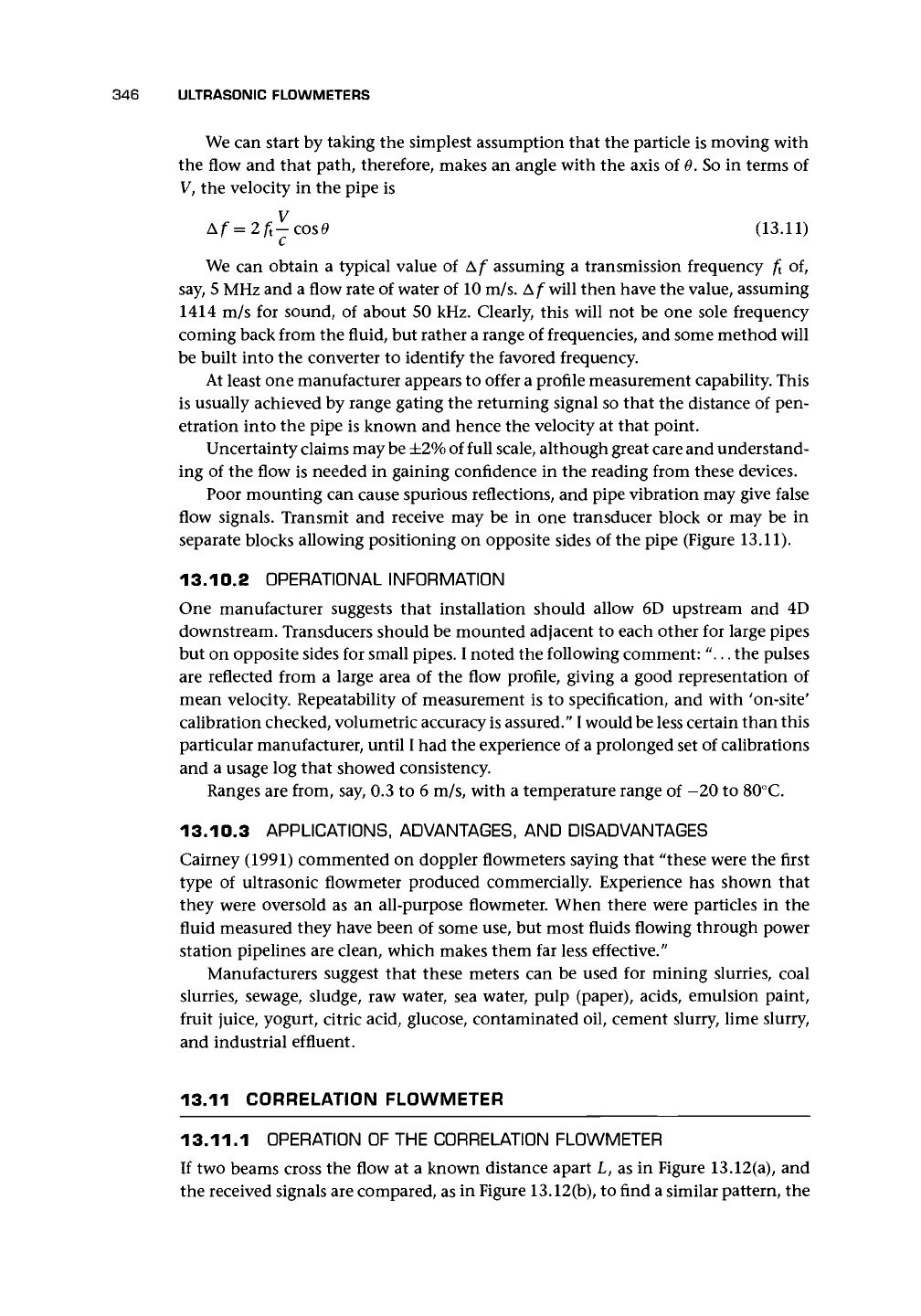
346 ULTRASONIC FLOWMETERS
We can start by taking the simplest assumption that the particle is moving with
the flow and that path, therefore, makes
an
angle with the axis
of
6. So
in
terms of
V, the velocity
in
the pipe
is
Af
=
2f
t
-cos6
(13.11)
We
can
obtain
a
typical value
of Af
assuming
a
transmission frequency
f
t
of,
say, 5 MHz and a flow rate of water
of
10 m/s.
A
f
will then have the value, assuming
1414
m/s for
sound,
of
about
50
kHz. Clearly, this will
not be one
sole frequency
coming back from the fluid, but rather a range of frequencies, and some method will
be built into the converter
to
identify the favored frequency.
At least one manufacturer appears to offer a profile measurement capability. This
is usually achieved by range gating the returning signal so that the distance
of
pen-
etration into the pipe
is
known and hence the velocity
at
that point.
Uncertainty claims may
be
±2% of full scale, although great care and understand-
ing
of
the flow
is
needed
in
gaining confidence
in
the reading from these devices.
Poor mounting can cause spurious reflections, and pipe vibration may give false
flow signals. Transmit
and
receive may
be in one
transducer block
or
may
be in
separate blocks allowing positioning
on
opposite sides
of
the pipe (Figure 13.11).
13.10.2
OPERATIONAL INFORMATION
One manufacturer suggests that installation should allow
6D
upstream
and 4D
downstream. Transducers should be mounted adjacent
to
each other
for
large pipes
but on opposite sides for small pipes. I noted the following comment:
"...
the pulses
are reflected from
a
large area
of
the flow profile, giving
a
good representation
of
mean velocity. Repeatability
of
measurement
is to
specification, and with 'on-site'
calibration checked, volumetric accuracy
is
assured/'
I
would be less certain than this
particular manufacturer, until I had the experience
of
a prolonged set of calibrations
and
a
usage log that showed consistency.
Ranges are from, say, 0.3
to 6
m/s, with
a
temperature range
of
-20
to
80°C.
13.10.3
APPLICATIONS, ADVANTAGES,
AND
DISADVANTAGES
Cairney (1991) commented
on
doppler flowmeters saying that "these were the first
type
of
ultrasonic flowmeter produced commercially. Experience
has
shown that
they were oversold
as an
all-purpose flowmeter. When there were particles
in the
fluid measured they have been
of
some use, but most fluids flowing through power
station pipelines are clean, which makes them
far
less effective."
Manufacturers suggest that these meters
can be
used
for
mining slurries, coal
slurries, sewage, sludge, raw water,
sea
water, pulp (paper), acids, emulsion paint,
fruit juice, yogurt, citric acid, glucose, contaminated oil, cement slurry, lime slurry,
and industrial effluent.
13.11 CORRELATION FLOWMETER
13.11.1 OPERATION OF THE CORRELATION FLOWMETER
If two beams cross
the
flow
at a
known distance apart L,
as in
Figure 13.12(a),
and
the received signals are compared, as
in
Figure 13.12(b),
to
find a similar pattern,
the
